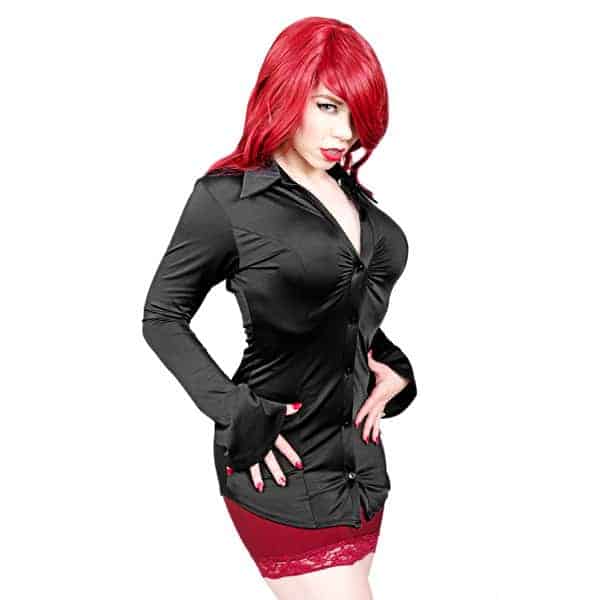
The early form of jeogori is hypothesized to have originated or have been influenced by Ho-bok, nomadic dress worn by northern nomadic people in Asia. Contemporary jeogori are presently designed with various lengths. However, due to reformation efforts and practical reasons, late modern jeogori for women was longer than its earlier counterpart with its length still above the waistline There are various styles and types of jeogori varying in fabric, sewing technique, and shape. While men's jeogori remained relatively unchanged, women's jeogori became dramatically shortened during the latter half of the Joseon dynasty, reaching its shortest length at the late 19th century. The form of Jeogori has changed over time. One from a Yangcheon Heo clan tomb is dated 1400–1450, while the other was discovered inside a statue of the Buddha at Sangwonsa Temple (presumably left as an offering) that has been dated to the 1460s. There are two jeogori artifacts that may be the earliest surviving archaeological artifact. Women's jeogori may have kkeutdong ( Hangul: 끝동), a different colored cuff placed at the end of the sleeves. The goreum ( Hangul: 고름) are fabric-strings that tie the jeogori. Dongjeong ( Hangul: 동정) is a removable white collar placed over the end of the git and is generally squared off. Gil ( Hangul: 길) is the large section of the garment on both front and back sides, and git ( Hangul: 깃) is a band of fabric that trims the collar. The basic form of a jeogori consists of gil, git, dongjeong, goreum and sleeves.

It covers the arms and upper part of the wearer's body. The jeogori is the basic upper garment of the hanbok, worn by both men and women. For women, there are Jang-sam, Dan-sam, Won-sam, and more. For men, some examples are Durumagi, Dopo, Danryeong-ui, Joong-chimak, Sochang-ui, Daechang-ui, etc. On top of this ensemble, there are also a variety of vests, jackets and coats. Men's hanbok consist of jeogori and loose fitting baji (trousers). The ensemble is often known as ' chima jeogori'. Traditionally, women's hanbok consist of the jeogori (top) and the chima (skirt). Joseonot, which was more popular in the north, replaced the other words in North Korea after the division of Korea. Other words with the same meaning, uriot ( Hangul: 우리옷) and joseonot ( Hangul: 조선옷), were concurrently used. Influenced by rising nationalism in the 1900s, hanbok became a word that meant the unique Korean clothing that can be distinguished from that of foreigners, such as Japanese, Western, and Chinese clothing. After the March 1st Movement, hanbok became a significant ethnic symbol of Koreans. Hanbok was used in a 1905 newspaper article, which described the righteous army wearing Korean clothing. īeginning in 1900, Korean newspapers used the hanja han in words that describe Korean clothing, such as hanguguibok ( Hangul: 한국의복), hangugyebok ( Hangul: 한국예복) and daehannyeobok ( Hangul: 대한녀복). The origin of the name remains unclear, because these documents predate the Korean Empire ( Hangul: 대한제국) which popularized the hanja letter Han (韓). Hanbok was used in a 1895 document describing the assassination of Empress Myeongseong to distinguish Korean clothing from Japanese clothing.

In the document, hanbok was used to distinguish Korean clothing from Japanese traditional clothing and Western clothing. The first recorded evidence of the name hanbok is from a 1881 document Jeongchiilgi ( Hangul: 정치일기).

In 1996, the South Korean Ministry of Culture, Sports and Tourism established "Hanbok Day" to encourage South Korean citizens to wear the hanbok. Ĭontemporary Koreans wear hanbok for formal or semi-formal occasions and events such as weddings, festivals, celebrations, and ceremonies. However, present day hanbok, which is worn nowadays, is patterned after the hanbok worn in the Joseon dynasty. These basic structural features of the hanbok remains relatively unchanged to this day. The basic structure of hanbok was designed to facilitate the ease of movement and integrated many motifs of Mu-ism. The ancient hanbok consisted of a jeogori (top), baji (pants), chima (skirt), and the po (coat). The basic structure of the hanbok was established at least since this period. Early forms of hanbok can be seen in the art of Goguryeo tomb murals of the same period, with the earliest mural paintings dating to the 5th century. The earliest visual depictions of hanbok can be traced back to the Three Kingdoms of Korea period (1st century BC–7th century AD), with roots in the Proto-Koreanic people of what is now northern Korea and Manchuria. The term "hanbok" literally means "Korean clothing". The hanbok (in South Korea) or Chosŏn-ot (in North Korea) is traditional Korean clothes.


 0 kommentar(er)
0 kommentar(er)
